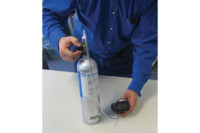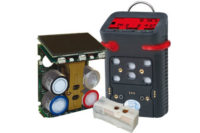
PHOTO: BW Technologies’ MicroDock II automatic test and calibration station
In the world of gas detection instrumentation, the expression “better safe than sorry†certainly holds true. Manufacturers and regulatory agencies agree the safest and most conservative approach to assuring instrumentation accuracy is to perform a functional test by exposing the instrument to known concentration test gas before each day’s use. “Docking stations†make functional testing and calibration automatic and easy to administer.
Oxygen deficiencies, explosive atmospheres and exposure to toxic gases and vapors injure or kill hundreds of workers every year during confined space entry procedures. The atmospheric conditions that lead to these accidents and fatalities are usually invisible to the workers involved. The only way to ensure atmospheric conditions are safe is to use an atmospheric monitor, and the only way to know that a gas detector’s readings are accurate is to expose the instrument to known concentration test gas.
Exposing the instrument to known concentration test gas verifies both the accuracy of the readings, as well as the proper performance of the instrument’s alarms. Failure to periodically test and document the performance of your confined space gas detectors can leave you open to regulatory citations or fines, as well as increased liability exposure in the event that a worker is injured in an accident.
Performing a functional “bump test†to verify the performance of the instrument by exposing it to known concentration test gas before each day’s use is very simple and takes only a few seconds to accomplish. It is not necessary to make a calibration adjustment unless the readings are found to be inaccurate. The regulatory standards that govern confined space entry procedures are in agreement with this approach.
Why instruments lose accuracy
Confined space gas detectors usually include several different types of sensors. The atmosphere in which the instrument is used can have profound effect on the sensors. Each type of sensor uses a slightly different detection principle. Sensors may be poisoned or suffer degraded performance if exposed to certain substances. The kinds of conditions that affect the accuracy of sensors vary from one type of sensor to the next.Combustible sensors are particularly prone to damage due to exposure to poisons or substances that inhibit the sensor’s response to combustible gas. Combustible sensors may be affected by exposure to silicone-containing substances, chlorinated solvents, sulfides (including H2S), or even exposure to high concentrations of combustible gas. Sensors may also suffer loss of sensitivity due to aging or desiccation, mechanical damage due to dropping or immersion, or loss of sensitivity due to other causes.
Calibration: two steps
Calibration is usually a two-step procedure. In the first step the instrument is taken to a fresh air environment, and “zeroed†so that the readings equal those expected in clean air: 20.9% for oxygen, 0% LEL for combustible gas, and 0 PPM for toxic gas. The second step is to expose the instrument to calibration gas that contains known concentrations of the contaminants the sensors are designed to measure. The readings are then adjusted to match these values.In most cases, confined space gas detectors automatically adjust their readings to match the concentrations in the calibration gas being applied. Follow the manufacturer’s instructions carefully. Different manufacturers use different concentrations during automatic span calibration adjustment procedures. Be especially careful to verify that the values used by the instrument to adjust the readings of the sensors are the same as the concentrations listed on the label of the calibration gas cylinder. Using the wrong concentration calibration gas can result in dangerously inaccurate readings. Be careful also to use the correct regulators and fittings to supply calibration gas to the instrument. Incorrect flows produced by an improperly set regulator or improvised fittings can produce inaccurate readings.
Given the requirement for documentation, the capability of instruments to log or automatically retain calibration information is highly desirable. Most datalogging confined space instruments automatically update and store dates and other calibration information. Even non-datalogging instruments usually include the date, or number of days since the last time the instrument was calibrated.
Less labor-intensive
Most leading manufacturers of confined space gas detectors now offer automatic calibration or “docking†stations that can automatically calibrate and store instrument calibration records. Docking stations that include fully automatic calibration are redefining the way that users with large numbers of confined space instruments deal with maintenance and calibration issues. Instead of technicians or instrument specialists laboriously calibrating instruments one at a time, instrument users simply drop the gas detector into the docking station. The docking station automatically bump tests or calibrates the instrument, then updates and stores the test results. Use of automatic calibration stations makes it possible to verify the accuracy of confined space instruments on a much more frequent basis.The prices for automatic calibration stations are beginning to drop in the same way that prices for confined space instruments have been dropping. In the past, it might take 40 or more instruments to justify the expense of investing in a docking station. As prices continue to come down, customers with only a few instruments are finding that investing in an automatic calibration station makes good sense.
Confined space gas detectors are designed to help keep workers safe in potentially life-threatening environments. Verifying the proper performance of your gas detectors is a mandatory part of every confined space entry program. But more importantly, it’s an essential part of keeping your workers safe.
Sidebar: What causes calibration drift?
Over time, the accuracy of gas detection instruments can diverge from their calibration settings in several ways:- Gradual chemical degradation of sensors and drift in electronic components that occur naturally over time.
- Chronic exposures to, and use in, extreme environmental conditions, such as high/low temperature and humidity, and high levels of airborne particulates.
- Exposure to high (over-range) concentrations of the target gases and vapors.
- Chronic or acute exposure of catalytic hot-bead LEL sensors to poisons and inhibitors. These include: volatile silicones, hydride gases, halogenated hydrocarbons and sulfide gases.
- Chronic or acute exposure of electrochemical toxic gas sensors to solvent vapors and highly corrosive gases.
- Harsh storage and operating conditions, such as when an instrument is dropped onto a hard surface or submerged in liquid. Normal handling/jostling of the equipment can create enough vibration or shock over time to affect electronic components and circuitry.
Often, after exposure to the more extreme conditions above, when calibration is attempted, the detector will either display a failure message or it will not allow the user to fully adjust the display reading. At this point, the severely damaged sensor must be replaced and/or the detector serviced by qualified personnel.
Source: OSHA

